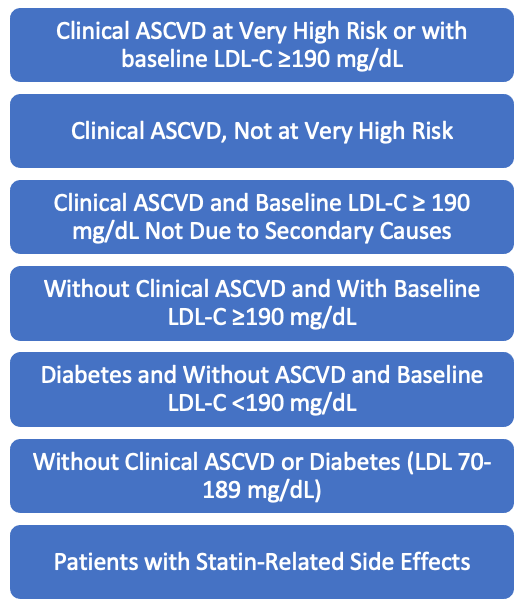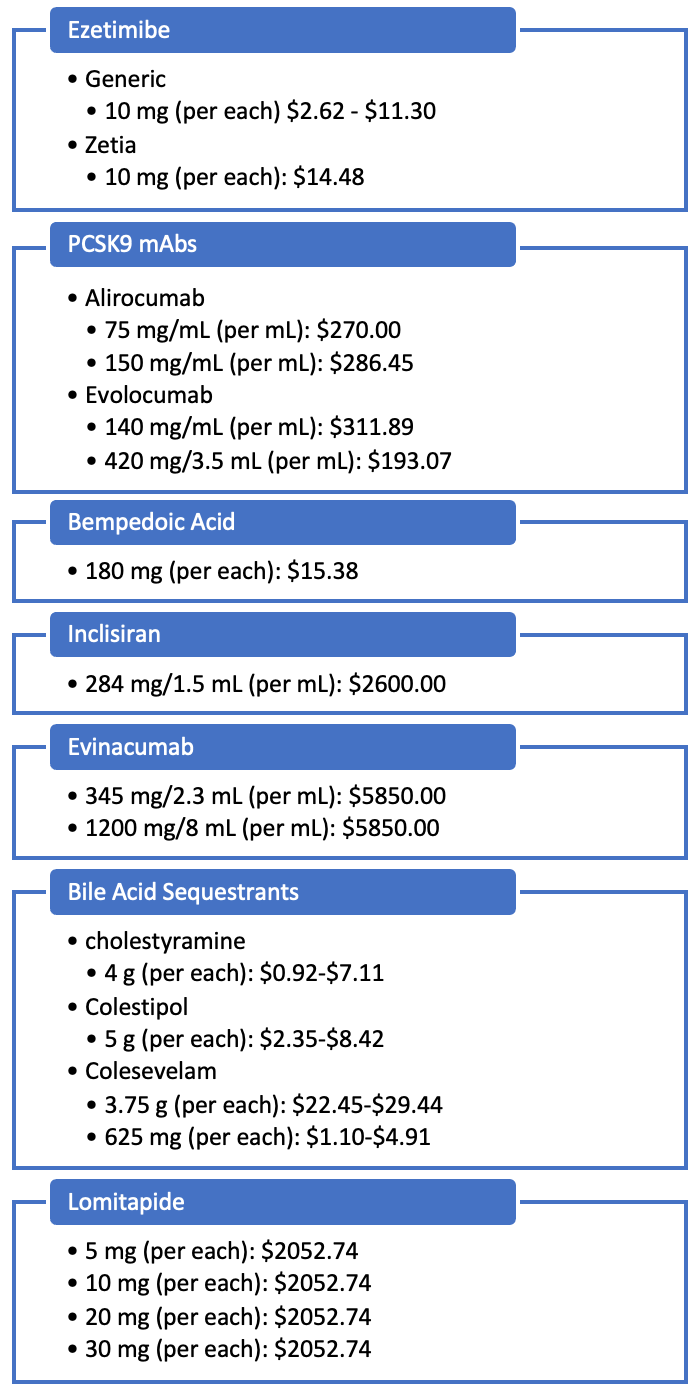Article
2022 ACC Consensus on Role of Nonstatin Therapies for LDL-Cholesterol Lowering
Author(s):
Since the 2018 guideline’s publication, additional non-statin therapies such as bempedoic acid, evinacumab, and inclisiran, have been approved by the FDA for the management of hypercholesterolemia.
Background
The 2018 AHA/ACC/multisociety Guideline on the Management of Blood Cholesterol provides recommendations to match the statin and non-statin therapy to the appropriate intensity of low-density lipoprotein cholesterol (LDL-C) reduction.1
Credit: jarun011 - stock.adobe.com

While statins remain the foundation for lipid-lowering therapy to reduce serum cholesterol and atherosclerotic cardiovascular disease (ASCVD) events, additional interventions may be needed to further reduce LDL-C.
Since the 2018 guideline’s publication, additional non-statin therapies such as bempedoic acid, evinacumab, and inclisiran, have been approved by the FDA for the management of hypercholesterolemia. Considering these new innovations, the 2022 ACC consensus statement serves to provide practical recommendations for selecting non-statin therapies until a formal systematic review can be completed.
Patient Groups to Consider for Additional Non-Statin Therapy

Current First-Line Therapies
Ezetimibe
- Reduces cholesterol absorption through inhibition of the NPC1L1 protein, preventing cholesterol absorption in the small intestine.
- Dosed orally once daily.
- 25% reduction in LDL-C combined with statin.
- Adverse events (AEs): nasopharyngitis, myalgia, upper respiratory tract infection, arthralgia, and diarrhea.
Factors to consider ezetimibe as the initial choice of non-statin therapy:
- In patients who require 25% additional lowering of LDL-C.
- Recent ACS event (< 3 months).
- Ease of oral administration.
- For cost-conscious patients.
PCSK9 monoclonal antibodies (mAbs)
Human mAb that binds to PCSK9, increasing the number of LDL receptors available to clear LDL-C.
- Alirocumab:
- SQ injection every 2 weeks, titrated to max dose.
- AEs: nasopharyngitis, injection site reactions, influenza, noncardiac chest pain, nasopharyngitis, and myalgia.
- 45%-58% reduction in LDL-C, when combined with statin.
- Evolocumab:
- SQ injection every 2 weeks or monthly, depending on dose.
- AEs: nasopharyngitis, upper respiratory tract infection, influenza.
- 58%-64% reduction in LDL-C.
Factors to consider a PCSK9 mAb as the initial choice of non-statin therapy:
- In patients who require 25% additional lowering of LDL-C.
- Less-frequent administration.
If the response to statin therapy, ezetimibe, and/or PCSK9 mAbs is deemed inadequate:
- Bempedoic Acid
- Small molecule that inhibits ATP-citrate lyase, resulting in up-regulation of the LDL receptor and increased clearance of LDL-C.
- FDA approved as an adjunct for ASCVD or the treatment of heterozygous familial hypercholesterolemia (HeFH).
- Prodrug dosed orally once daily.
- 17%-18% reduction in LDL-C, when combined with statin.
- AEs: Upper respiratory tract infection, muscle spasms, hyperuricemia, back pain, abdominal pain, bronchitis, pain in extremity, anemia, elevated liver enzymes.
- Option for patients with statin-associated muscle symptoms as it is not activated in muscle cells.
Factors to consider bempedoic acid as an adjunct:
- Patients with a statin intolerance.
- Ease of oral administration.
Inclisiran
- Small interfering ribonucleic acid that silences the translation of PCK9 messenger ribonucleic acid, inhibiting translation of the PCSK9 protein and upregulating the LDL receptor.
- Administered SQ on days 1 and 90, and then every 6 months thereafter.
- FDA-approved as an adjunct for patients with HeFH or ASCVD.
- 48%-52% reduction in LDL-C.
- AEs: Injection site reaction, arthralgia, urinary tract infection, diarrhea, bronchitis, pain in extremities, dyspnea.
May consider inclisiran in place of a PCSK9 mAb in patients with:
- Poor adherence to mAbs.
- An inability to self-inject.
Evinacumab
- Lipoprotein lipase and endothelial lipase are involved in lipoprotein metabolism, with ANGPTL3 acting as an inhibitor to these enzymes. Evinacumab functions as a fully human monoclonal antibody to inhibit ANGPTL3.
- Currently only approved for the treatment of homozygous familial hypercholesterolemia (HoFH) as an adjunct to other LDL-C-lowering therapies.
- Administered as a monthly IV infusion.
- 49% reduction in LDL-C in combination with other therapies.
- AEs: nasopharyngitis, influenza-like illness, dizziness, rhinorrhea, and nausea.
Consider as an adjunct therapy for patients with HoFH under the guidance of a lipid specialist.
Other Therapies
- Bile acid sequestrants (BAS).
- Reduce cholesterol absorption in the small intestine.
- Includes the products colesevelam, colestipol, cholestyramine.
Colesevelam
- Administered orally once or twice daily, available as a tablet or powder for suspension.
- 15% reduction in LDL-C as monotherapy and 26% reduction in combination.
Colestipol
- Orally once or twice daily.
- 16%-27% reduction in LDL-C as monotherapy.
Cholestyramine
- Orally twice daily.
- 10% reduction in LDL-C as monotherapy.
- AEs: Constipation, dyspepsia, and nausea.
- Modest hypoglycemic effect. May provide benefit in patients with diabetes if triglycerides are < 300 mg/dL.
- There is no evidence for a net cardiovascular risk reduction when BAS are used in addition to statins.
May consider in patients:
- Without triglyceridemia.
- With diabetes.
- With a statin intolerance.
Lomitapide
- Binds and inhibits microsomal triglyceride transfer protein. This action inhibits synthesis of chylomicrons and VLDL, decreasing LDL-C.
- Administered orally once daily, titrated up to maximum dose.
- Currently only approved to control LDL-C in patients with HoFH.
- 40%-50% reduction in LDL-C, in combination with other therapies.
- AEs: Diarrhea, nausea, vomiting, dyspepsia, and abdominal pain.
- Black box warning for elevations in liver transaminases and risk of hepatic steatosis.
- Consider in patients with HoFH with inadequate response to statins.
LDL-Apheresis
- Removes apo B-containing lipoproteins, resulting in an acute reduction in LDL-C.
- Extracorporeal technique performed weekly or biweekly.
- Used in patients with clinical ASCVD and HoFH or HeFH who have inadequate response to statins.
- 50%-60% reduction in LDL-C.
- AEs: Problems with venous access; transient hypotension, fatigue; bleeding; hypocalcemia, iron deficiency heparin allergy, and bradykinin syndrome.
Consider in patients with ASCVD and HoFH or HeFH with inadequate response to statin therapy under the guidance of a lipid specialist.
Cost Considerations for Non-Statin Therapies (AWP)

About the Author
Author: Mickenzie Meyers, PharmD Candidate, University of Minnesota – Twin Cities Class of 2023.
Preceptor: Linda Huang, PharmD, BCPS, BCACP, Clinic Pharmacist, Division of General Internal Medicine at Mayo Clinic.
Reference
Writing Committee, et al. 2022 ACC Expert Consensus Decision Pathway on the Role of Nonstatin Therapies for LDL-Cholesterol Lowering in the Management of Atherosclerotic Cardiovascular Disease Risk: A Report of the American College of Cardiology Solution Set Oversight Committee. Journal of the American College of Cardiology. 2022; 80.14: 1366-1418.






